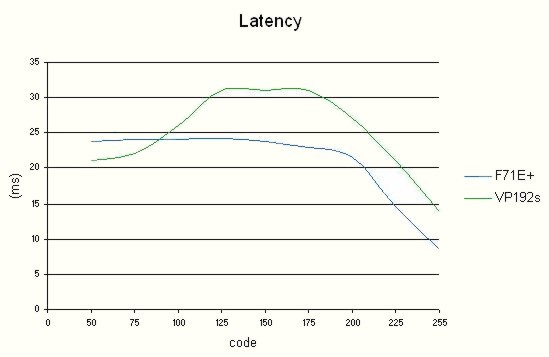ViewSonic Overdrive LCDs: A New Era of Very Fast Panels?
Latency
We measured the actual latency of the two panels:
Again we'll recall our test method:
The curve shows the different latency values for different levels of gray. A black-white alternation is shown on the curve by a point at X-axis 255, a black-gray alternation produces a point at X-axis 125, a black-gray alternation shows as 50, etc.
The official ISO latency rating specified by the manufacturer is only for black/white transitions (0/255). While the value we measured agrees with the manufacturer on this point, it's not of much value in judging the actual responsiveness of the panel in practice.
This is classic TN performance. The 12 ms 19" AU Optronics panel has never been a speed demon, and it shows here. The maximum latency was 32 ms. In the best cases it tested at 14 ms under humanly bearable conditions. In fact, there's nothing new about this and certain manufacturers who use this panel hesitate to rate it at 12 ms.
The case of the VP191b is a good deal more interesting.
VP191b
Finally we have a monitor that delivers what we'd been waiting for so long - a panel that's constantly below 16 ms of latency. This is because it does no good to have a panel capable of 8 ms if the actual latency attains values of 25 or even 30 ms in the worst cases. The 8 ms Samsung panels, for example, aren't fast because they attain 8 ms at the ISO measurement point, but because their maximum latency is "only" 26 ms. The VP191b has put all other LCD panels on notice. The ISO latency of this MVA/Overdrive panel is only 15 ms, but that 15 ms is constant throughout the use range.
Get Tom's Hardware's best news and in-depth reviews, straight to your inbox.
What counts is being able to sustain 60 frames per second (16.6 ms per frame) regardless of the content of the image (and therefore regardless of the color or level of gray). And that's what the AU Optronics 190EN03 V.0 panel does.
In short, this panel delivers EXACTLY what an LCD panel should: Latency below 16 ms over the entire use range.

